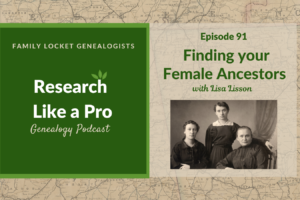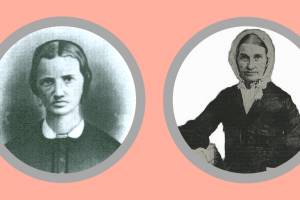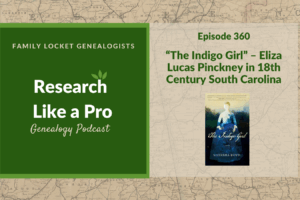
When we encounter women named in deeds, probate, or court records, finding and understanding the law behind the action helps us in our research. We find the law by looking for the federal or state statutes on which the action was based. Understanding the law can be more difficult. Marylynn Salmon’s book, Women and the Law of Property in Early America fills that void.
We’re reading this book for our fall selection of the FamilyLocket Book Club on Goodreads. This is one to digest in small bits. I recommend choosing a chapter that appeals to you and learning about the geographical location where you conduct your research. Chances are, you’ll have some women in your family history research that will come to mind as you read, and you can apply what you learn to her situation, whether it is marriage, widowhood, or divorce. Each of these marital states had accompanying laws and statutes that significantly impacted her life.
Published in 1989 by the University of North Carolina, a description on their website summarizes the book.
In this first comprehensive study of women’s property rights in early America, Marylynn Salmon discusses the effect of formal rules of law on women’s lives. By focusing on such areas such as conveyancing, contracts, divorce, separate estates, and widows’ provisions, Salmon presents a full picture of women’s legal rights from 1750 to 1830.
Salmon shows that the law assumes women would remain dependent and subservient after marriage. She documents the legal rights of women prior to the Revolution and traces a gradual but steady extension of the ability of wives to own and control property during the decades following the Revolution. The forces of change in colonial and early national law were various, but Salmon believes ideological considerations were just as important as economic ones.
Women did not all fare equally under the law. In this illuminating survey of the jurisdictions of Connecticut, Massachusetts, New York, Pennsylvania, Maryland, Virginia, and South Carolina, Salmon shows regional variations in the law that affected women’s autonomous control over property. She demonstrates the importance of understanding the effects of formal law on women’ s lives in order to analyze the wider social context of women’s experience.
 For an idea of the breadth of material Salmon studied for her book, the bibliography has numerous titles under each heading
For an idea of the breadth of material Salmon studied for her book, the bibliography has numerous titles under each heading
- Manuscript Sources
- Case Reports
- Legal Treatises, Abridgments, and Digests
- Statutes
- Books and Articles
A general index and complete documentation with endnotes throughout the book speak to our wish as genealogists to know the source of Salmon’s assertions. These also enable us to find the source material ourselves.
The book is readable and fascinating, but it needs your full attention. I read only a few pages at a time so I could absorb the information. I also used my highlighter to pull out the key points as I read.
About the Author
 In the acknowledgments section at the beginning, Marilynn Salmon thanks the many people who read sections of the book and provided feedback. In a work of this scope, that feedback is invaluable. She states that much of the book is taken from her Ph.D dissertation. She also presented the portion to fellow historians at various seminars and published excerpts in journals such as the William and Mary Quarterly.
In the acknowledgments section at the beginning, Marilynn Salmon thanks the many people who read sections of the book and provided feedback. In a work of this scope, that feedback is invaluable. She states that much of the book is taken from her Ph.D dissertation. She also presented the portion to fellow historians at various seminars and published excerpts in journals such as the William and Mary Quarterly.
For a taste of Salmon’s work, here are some articles online.
The Legal Status of Women, 1776-1830.
The Legal Status of Women in Early America: A Reappraisal.
For a list of Salmon’s work, see her profile on Google Scholar.
Preface and Chapter One
The author lays out her concerns about women’s legal history in the preface. She elaborates on each, explaining that to understand women and the law, we need to understand the law and then see how it was applied through actual cases.
First, we want to understand how the law functioned in practice, as well as in theory, because we want to know how legal rules affected women’s day-to-day lives.
Second, historians of women’s legal status are centrally concerned with understanding the meaning of change over time.
The third concern is perhaps the most important of all to the field; it encompasses the working of the law in practice as well as in the meaning of change over time. (p. xi)
Salmon chose to focus on the years 1750 to 1830 and gives us examples of how the law affected women before and after the American Revolution. She also studied a sampling of regions: New England, New York, Pennsylvania, Virginia, and South Carolina. Throughout the book, I was fascinated to see how the ideology concerning women and property varied based on regional differences.
Chapter One is titled “Diversity in American Law.” Before reading Women and the Law of Property, I was under the assumption that the English common law that the British colonists brought with them was standard. Instead, Salmon explains that there was diversity in England on how law and property worked regarding women.
Because the colonists also had their own ideas about how women and property should be handled, each unique area developed different statutes and precedents. For example, New England jurists operated on the ideal that a couple should be unified and, therefore, a woman would never need any special rights regarding land. Her husband, as an upstanding citizen and spouse, would handle all their affairs properly. Of course, this approach didn’t work out well when the man of the house was dishonest, deeply in debt, or deserted his wife, among other issues.
On the other hand, in South Carolina, mortality rates for men were high, and women needed more rights regarding the land to keep the plantation running. The unique southern economy based on slavery dictated the interpretation of the common law handling of land and women.
The book covers several different aspects of the law of property and women. Each chapter discusses how each topic was handled in the different jurisdictions using specific case studies.
- Two: Conveyances
- Three: Contracts
- Four: Divorce and Separation
- Five: Separate Estates
- Six: Separate Estates in New England
- Seven: Provision for Widows
Organizing the book by subject and then discussing each jurisdiction in turn allows the reader to become immersed in the subject. Let’s look briefly at each chapter and an example of how some of the jurisdictions handled each situation.
Conveyances
Under the common law, once a woman married, she and her husband were “one” and she became a feme covert. She could no longer sell property in her own right, even if she brought the property into the marriage. Instead, her husband took care of all such matters. Ideally, this would be fine, but the colonists recognized that in many instances, a woman needed some say in selling property that supposedly they jointly owned.
Thus, we see in many deeds a wife giving her consent to the sale of the land. Women were to be privately examined to ensure no coercion by the husband in giving her consent. Each jurisdiction handled this differently, but in the South, Salmon asserts that the three southern colonies studied, Maryland, Virginia, and South Carolina, enforced this strictly.
Contracts
As a feme covert, a wife couldn’t enter into a business contract or own or operate businesses in their own name. This became a problem if the husband was away for extended periods of time or if he was not capable of providing for the family. Recognizing the issue, some jurisdictions enacted statutes that allowed a married woman to become a feme sole trader. Salmon states:
An Act concerning feme-sole traders,” enacted by the General Assembly of Pennsylvania in 1718, provided that the wives of “mariners and others, whose circumstances as well as vocations oblige them to go to sea’ could act as feme sole traders during their husbands’ natural lives.” (p. 48.)
Divorce and Separation
During the colonial era, opinions and laws on divorce and separation varied widely among the jurisdictions studied. But after the Revolution, many states quickly enacted laws and statutes that allowed for divorce. Because a married woman was unable to act on her own behalf regarding property, if a husband deserted her, she faced many challenges. If she wanted to sell their land and move on, she was hampered. Also, in cases of abuse, adultery, or other situations, women needed a legal way to separate from their husbands. Salmon states:
In 1786 Massachusetts lawmakers formalized grounds for the first time. Absolute divorces were obtainable for adultery, impotence, and criminal conviction carrying a prison sentence of seven years. Husbands and wives could obtain separations for desertion, and wives could obtain them for nonsupport. (p. 63)
Separate Estates
In England, separate estates were used to legally allow women to own and control property separate from their husbands. This was the exception to the rule and was generally used for the landed class. Marriage settlements were important when a wife brought property into a marriage from an inheritance or previous marriage. That property needed protection in the case of creditors seeking to settle debts with the insolvent husband. Salmon states :
The usual goals in settling property on a woman were to prevent it from being taken to pay the debts of her husband and to provide her with support for understandable reasons, creditors disliked trust estates, particularly those made after marriage. (p. 93)
Chancery courts handled these issues. In the colonies that Salmon studied, only New York, Maryland, Virginia, and South Carolina created these courts of chancery.
Separate Estates in New England
Salmon includes a separate chapter on New England, as Connecticut and Massachusetts did not create separate courts of chancery to deal with trust estates. The Puritan ideals that governed much of the colonial attitudes were opposed to women having control over property. Both colonies/states approached the issue differently, and Women and the Law of Property devotes some space to the discussion.
The very idea of separate property spoke to a corruption of family life that Puritan leaders feared and sought to suppress. Although individuals still occasionally relied on marriage settlements to define the respective rights of wives and husbands, lawmakers never acknowledged the practice by assigning jurisdiction to the courts. (p. 123).
Provision for Widows
As researchers, we frequently encounter a woman releasing her dower rights in deeds. Under English common law, a widow had the right to one-third of the real property owned by her husband during their marriage. If there were no children to inherit, the widow could claim up to one-half of the property. A man could write a will giving his wife more than what the law required, but he could not give her less. The widow was to have a life interest in the land, but could not sell or devise it. She was to benefit from the rents and profits of the land.
Although all the colonies adopted the common law of dower, differences arose in how it was actually enforced. In the colonies and states where land was valuable to the economy, dower was seen by some jurists as detrimental. Laws evolved differently in the various jurisdictions, and Salmon discusses each of those studied in turn. For example, in Virginia, enslaved people as property had to be defined.
Using the Information
How best can we, as family historians, use Salmon’s excellent book? I’d recommend purchasing a copy and referring to it whenever you come across a record involving your female ancestor and property – whether it’s real or personal property. If Salmon discusses your colony/state, you will gain new insights into the record.
What if your jurisdiction is not mentioned? I’d recommend reviewing the sections on a neighboring jurisdiction, then looking for the laws governing your ancestor’s actions.
Finding and understanding the law that affected our ancestors’ actions can be difficult, but Women and the Law by MaryLynn Salmon provides an excellent guide to enhance our understanding.
Best of luck in all your genealogical research!














Leave a Reply
Thanks for the note!